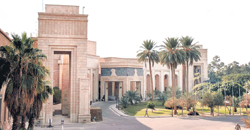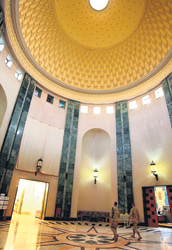
|
Saddam's ornate palaces live on after his death BAGHDAD, (AFP) -Saddam Hussein is dead but memories of the grandiose excesses of his 24-year reign live on in his resplendent palaces, still used by the US forces which deposed him in 2003. The late dictator built eight ornate presidential palaces across Iraq that embodied absolute power, the last word in dictatorial chic that for many of his opponents were hated symbols of repression. "Oh children of ancient Mesopotamia, do not believe what you may hear outside the homeland!" says an Arabic inscription at Saddam's Republican Palace in Baghdad.
"You have only to look to your leader-president, your leader-struggler, Saddam Hussein. Believe only what he tells you, and take all else as rumour and lies!" it exhorts the overawed visitor. Intended as symbols of Saddam's absolute power, many of the palaces are today used by American forces who invaded Iraq and deposed him in 2003. Soldiers have taken oaths of US citizenship in the Al-Faw palace, swearing allegiance in the despot's resplendent rotunda hall to a country he loathed. A third Baghdad palace, which lies in the heavily fortified zone that houses the headquarters of the new US-backed regime, has become the largest American embassy in the world. The basic building -- named the People's Palace –dates back to the 1930s but Saddam added another two wings with a 1995 inscription praising him as "Mr President, supreme leader Saddam Hussein, whom God protects". His regime liked to call the palatial fortresses "palaces of the people"but few people outside his Baath party ever got past their heavily fortified walls. The ornate palaces, some boasting domes, cover a total of 31.5 square kilometres (11.8 square miles), one third of which is taken up by artificial lakes.
They contain about 1,000 buildings, including luxury mansions, guest villas, offices, warehouses and garages, said a UN team that visited in 1998. Outside Baghdad, palaces were built in Saddam's hometown Tikrit, near where he was buried Sunday, and in Basra and Mosul, Iraq's second and third cities. The final two are in Thar Thar, overlooking a lake in Salaheddin province northwest of Baghdad, and another a short distance away at Jabal Makhul, near Samarra. Despite the miserable plight of millions of Iraqis, Saddam lavished his palaces with attention and money, importing crateloads of marble fashioned into lavish corridors, salons, gold-embossed doors and intricate mosaics. He demanded that thousands of bricks be inscribed with his signature SH, meaning that today's American diplomats in Baghdad work surrounded by thousands of initials of one their government's most determined enemies. But the palaces were not only intended as flashy tributes. The Republican Palace, nicknamed Believers' Palace by the Americans, was to disguise a state-of-the-art bunker intended to withstand a Hiroshima-style attack. US forces dropped two 900 kilogramme (2,000 pound) GBU-28 bunker-busting bombs on the building on the opening night of the US-led invasion, followed up by at least six more bunker-busters, causing impressive damage. "The smart bombs went through the dome but exploded when they hit the fake floors. Look here: this is the beginning of the structure of the bunker. It's intact," said Tubbs. "It's a box in a box in a box."Begun in the 1980s, finished in 2000, looted in March 2003 and today guarded by the Americans, the bunker is being invaded by the filthy waters of the River Tigris. The atmosphere is rank, the water stagnant and the carpet decomposing. |
| || Front
Page | News
| Editorial
| Columns
| Sports
| Plus
| Financial
Times | International
| Mirror
| TV
Times | Funday
Times || |
| |
Copyright
2006 Wijeya
Newspapers Ltd.Colombo. Sri Lanka. |

